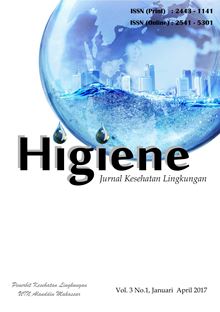Risk Factor of Urolithiasis in Redisari Village, Rowokele Sub Ditrict, Kebumen District
Abstract
The biggest case on urinary clinic is urolithiasis. Based on the medical record data of Kebumen Hospital, there were 91 patients, consist of 65 men (71.43 %) and 26 women (28.57 %) who treated as urolithiasis patiens in 2013. Urinary tract stone formation is influenced by intrinsic and extrinsic factors. Purpose : To analyze the risk factors of urolithiasis in Redisari village, Rowokele, Kebumen district.
This was an observational study with cross sectional design. The sample were 80 people taken by purposive sampling technique. The incidence of urolithiasis as the dependent variable, while the amount of intake of drinking, Ca content of drinking water, habit of holding urine, history of hypertension, history of urinary tract infections, consumption of supplements as independent variables. Data were collected through interviews and laboratory tests. Analyzed using univariate and bivariate analysis.
The laboratory examination of urine respondents, positive Ca oxalate urine 34 (42.5%) and negative 46 (57.5%). Respondents with a positive urinary Ca oxalate, 51% its drinking water intake is less than 2 liter dilay whereas 24% drinking water intake enough. The bivariate analysis of people who drink less than 2 liters daily at risk of suffering from urolithiasis, p value = 0.035 and PR = 2.112 (95% CI = 1.050 - 4.249). Those who drink less than 2 liters daily at risk for urinary tract stones (urolithiasis). It is recommended for adults to drink at least 2 liters daily to avoid urolithiasis.
Keywords : Risk factors, Urolithiasis, Redisari
References
Bartoletti R. (2007). Epidemology and Risk Factors in Urolithiasis. Urol Int, 79: 3-7.
Daman, Fitriah Amin. (2011) Inluence of Calcium Concentration in Drinking Water With Calcium Urin on Male At Ra’as Vilage, Klampis Subdistrict, Bangkalan Regenci, Madura, Jurnal Kesehatan “Wiraraja Medika”
Denstedt, John, Knoury, Saad. (2008). Stone Disease, 2nd, Paris France, Intrnational Consultation on Stone Desease.
Haryanto, Rudi. (2013). Keperawatan Medikal Bedah: Sistem Perkemihan. Yogyakarta, Rapha Publising, 55-67.
Marsidi, R. (2001) Zeolit untuk Mengurangi Kesadahan Air. Jurnal Teknologi Lingkungan. 2 (1) Januari:1 – 10.
Lina Nur. (2008) Faktor-Faktor Risiko Kejadian Batu Saluran Kemih pada Laki-laki
(Studi Kasus di RS Dr. Kariadi, RS Roemani dan RSI Sultan Agung Semarang). Tesis Magister Epidemiologi UNDIP.
Sandy, Wahap; Onny, Setiani; Tri, Joko. (2012). Hubungan Kandungan Mineral Calcium, Magnesium, Mangaan Dalam Sumber Air Dengan Kejadian Batu Saluran Kemih Pada Penduduk Yang Tinggal di Kecamatan Songgom Kabupaten Brebes. Jurnal Kesehatan Lingkungan Indonesia, Vol. 11 No. 2 / Oktober 2012.
Siener, R., Jahnen, A. dan Hesse, A. (2004) Influence of A Mineral Water Rich in Calcium, Magnesium and Bicarbonate on Urine Composition and The Risk of Calcium Oxalate Crystallization: Original Communication. Eur. J. Clin. Nutr, 58:270-76.
Supriyadi, Wagino., Sekar Ratih Widowati. (2011) Tingkat Kualitas Hidup Pasien Gagal Ginjal Kronik Terapi Hemodialistis. Jurnal Kemas,6 (2) 2011: 107 – 112.
Widiarti, Dwi, dkk. (2008). Kapita Selekta Penyakit dengan Implikasi Keperawatan. Alih bahasa. Edisi2. Jakarta, EGC, 88-90.


